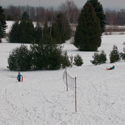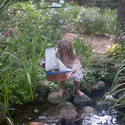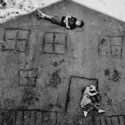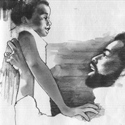Nothing I have ever done has resonated as much as the photos of what I called "feral houses" last summer. A quickly dashed-off blog post written while children tugged at my sleeves ended up capturing the attention of hundreds of thousands of people around the world and I still get hundreds of hits to that post every day. Even Alan Weisman, author of The World Without Us, e-mailed me about them. With a new summer here, I am tempted to add to the typology. Here we even have a feral church:
Living in Detroit, you can easily grow numb to the things that seem remarkable to people who live elsewhere. With so many journalists and photographers parachuting in over the past few years, we have allowed outsiders to document these things and define them. Detroiters are, after all, used to all the abandoned shit. We drive past the grand ruins without a second thought. It can also be easy to avoid the parts of the city where these "feral houses" are because there is little reason to go there: nature is taking them over because nothing else wants to be there. It is often easier to just travel the web of depressed freeways than it is to drive through depressing neighborhoods. But I'll always prefer a side road I've never seen to a rut I've been in a thousand times. Seeing these feral houses is a part of our daily life in this city, and I feel compelled to document them.
[this post has a lot of pictures, click here to see the whole thing, and if you click on individual pictures you can see them much bigger]
The trees grow so close to and on these houses because the city tractors that mow the lawns of abandoned homes don't get close enough to trim them as saplings. It is not unusual to see a phalanx of John Deere tractors mowing down the vacant lots of Detroit and I have even seen them working with commercial farm balers on city lots. Budget woes threatened to cut those services this year, and people were worried the whole city was going to go feral (the tractors have been out all over the city since).
On the Hilobrow blog, Matthew Battles describes the process of becoming feral as a sort of reenchantment. "If we think of the domesticated animal as some kind of technology," he writes, "then in a sense the feral creature is a broken tool—but if so, then it is a technology that is beautifully broken." I like the idea of the feral as something "beautifully broken." A lot of people responded to the photos posted last summer by saying there was no beauty in these houses, only sadness. But with nature taking over these structures, they share a certain picturesque quality with the ancient ruins that have been appreciated throughout modern history. In The Seven Lamps of Architecture, John Ruskin defined the picturesque as an "accidental beauty" that is wholly "inconsistent with the preservation of original character." The picturesque building is thus appealing in a way never foreseen by its architect. "It consists in the mere sublimity of the rents, or fractures, or stains, or vegetation, which assimilate the architecture with the work of Nature, and bestow upon it those circumstances of colour and form which are universally beloved by the eye of man."
There is a sadness here too. As many commentators have noted, people once cooked in the kitchens of these houses, slept in their rooms, shit in their toilets. Generations of children played in their yards, grew into adults within their walls and moved out into houses of their own. Building a house, more than any other act of architecture, is what separates us from beasts; even those wild creatures that build crude habitations are never completely sheltered from the elements. Our ancestors, they say, lived in caves, returning at night to those symbolic wombs in the earth. A house has meaning that goes deeper than most of us regularly consider. There is undoubtedly something unsettling about seeing nature invade a home built to keep it out.
Once we teach our pets to clench their bladders inside our homes we call them housebroken. To "break" an animal is to domesticate it: to make it worthy of our walls. When a house in Detroit becomes broken---even beautifully broken---it no longer has any purpose other than serving the plants that will grow from it. In this city, in this economy, none of these houses will ever be re-domesticated.
What is a house, really? Isn't it simply raw materials brought together to shelter us from the elements, from the wind and the rain and the bugs? And because they bear those burdens for us, a house is in perpetual decline. Without maintenance, every house is always on its way to ruin. Every homeowner that's ever paid a roofer knows this. A feral house exposes its vulnerable material core: concrete, wood, brick, mortar. Every home, even yours, will one day be broken down to such brute matter. In nature, you may not pay much attention to a stand of pine, or native limestone, clay, shale, or stone. But in a feral house you see these materials lain bare as they are brought back to nature. We see that these raw elements of nature underlie our most potent symbols of civilization.
A house is supposed to last longer than us; to see so many returning to earth is a grim reminder that our bodies share the same fate. These houses also represent that liminal state between humans and nature; maybe we aren't as far apart as we think. Maybe we were the first domesticated animals---God's pets---and like these houses we still have it in us to go wild.
[there are just a few of the super-cheap prints of feral house #13 left at 20x200, as well as about a hundred left of #7, in case you're interested; through Sunday, June 27, all art at 20x200 is 20% off!]




























































